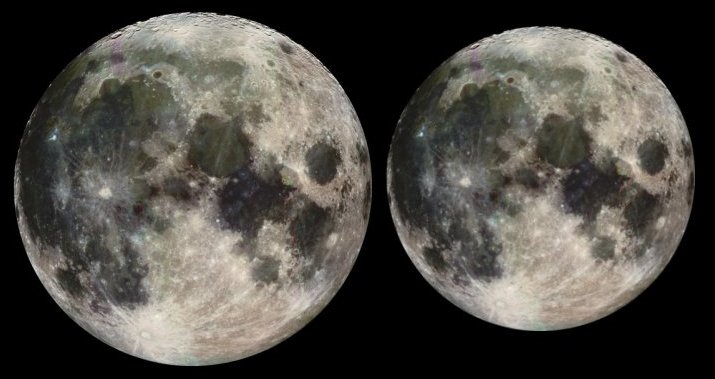Credit & Copyright: Galileo Project,
NASA
Explanation:
Tonight, those blessed with clear skies can enjoy a
glorious full moon,
the last full moon of the "Y1.9K"s.
In fact, tonight's moon will be a full-perigee-solstice moon,
reaching its full phase and perigee (the closest point in
its orbit)
on the solstice,
the first day of northern hemisphere winter.
Anticipation of this celestial event has generated
a flood of e-mail chasing the rumor
that the full-perigee-solstice moon will be intensely bright.
However, calculations show it will only be a little brighter than usual,
and certainly not dramatically so.
Why would it be brighter?
Mostly because the moon appears bigger and brighter at perigee.
The above illustration, based on
Galileo spacecraft images,
shows the approximate difference in apparent
size between a
full moon
at perigee (left) and a full moon at apogee,
the farthest point in the lunar orbit.
The Earth and moon are also a few percent closer to the sun
during northern winter,
but the combined effects will cause tonight's full moon to appear
only about 20% brighter than an average full moon.
That difference is not even likely to be noticeable to
the human eye.
1999 2000 2001 2002 2003 2004 2005 2006 2007 2008 2009 2010 2011 2012 2013 2014 2015 2016 2017 2018 2019 2020 2021 2022 2023 2024 2025 |
Январь Февраль Март Апрель Май Июнь Июль Август Сентябрь Октябрь Ноябрь Декабрь |
NASA Web Site Statements, Warnings, and Disclaimers
NASA Official: Jay Norris. Specific rights apply.
A service of: LHEA at NASA / GSFC
& Michigan Tech. U.
|
Публикации с ключевыми словами:
solstice - perigee - apogee - full moon - Moon - солнцестояние - полнолуние - Луна
Публикации со словами: solstice - perigee - apogee - full moon - Moon - солнцестояние - полнолуние - Луна | |
См. также:
Все публикации на ту же тему >> | |
